As an organic gardener next to growing your own veggies, it’s highly entertaining to watch birds visiting your garden. Feeding and hearing the bird’s melodies and chirping sounds are calming to the mind.
Since the natural habitat of birds is gradually diminishing, birds relocate to safer places looking for a steady source of food and water.
If you are able to provide an all-under-one-roof environment, birds would be happy to visit your garden and take shelter. Okay, let’s jump into the quick ways to attract birds to your garden or home.
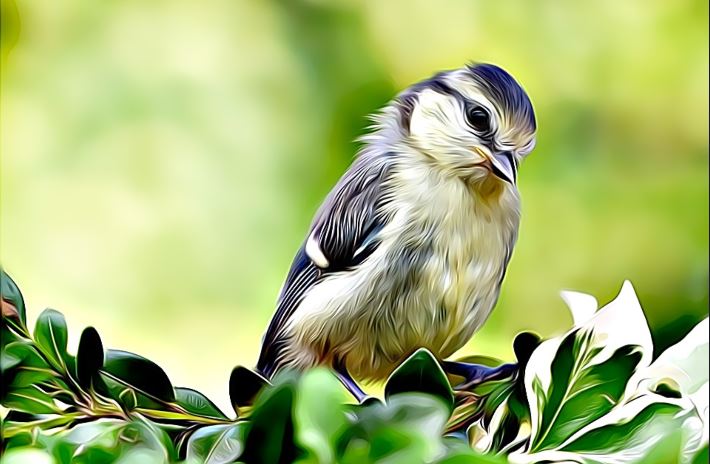
Reasons: Why You Should Attract Birds to Your Garden
- The presence of birds means your garden is healthy and it promotes a better local ecosystem.
- Birds like sparrows and finches eat a lot of weed seeds and control unwanted plants in your garden.
- They are not vegan, eliminating the need for pesticides they eat the majority of plant-destroying insects.
- Birds naturally fertilize your garden and their presence educate us and our kids about nature and migration.
- Having insects under control, they are also good pollinators resulting in better flowers and fruits after each harvest. Also, it promotes more flowers in your garden making it colorful and attracting more birds.
- Above all, birds singing and fluttering around your garden are relaxing and motivate you to be physically and mentally strong.
Related: How to attract bees to your garden
Quick Overview: What Attracts Birds to Your Garden
- Attract them with a variety of plants and a few trees that suit the native birds of your region.
- Add a feeding station with a variety of seeds.
- Provide clean drinking water and place a shallow birdbath.
- Encourage nesting with nesting spots.
- Earn their trust by making your garden safe for birds free from cats and similar predators.
- Initially add bright colors to your garden to attract them.
- Install birdhouses and feeders at an optimum height of 6-7 feet high above ground level.
- Clean your feeders and birdbath to prevent diseases. With all these steps you can create a microhabitat for the little birds to take refuge in your garden.
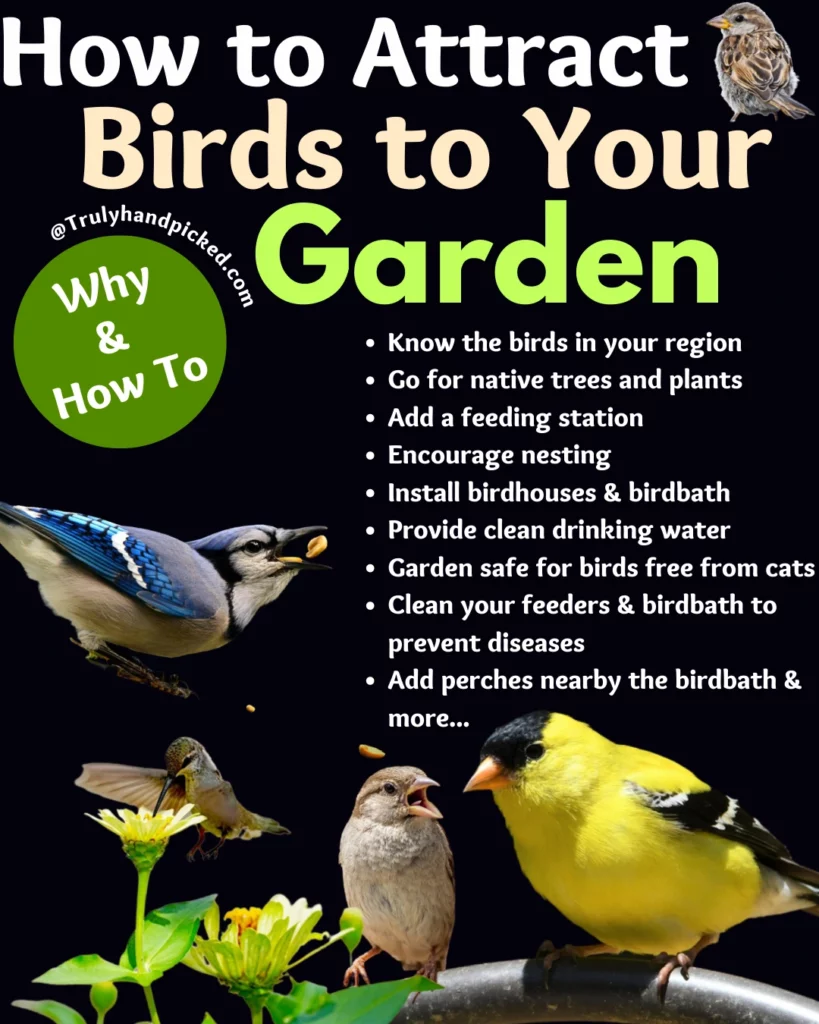
How to Attract Birds to Your Garden
Know the birds in your region:
By now you already know the few birds that flutter here and there. But, ask locals or search to know the list of birds in your region. So, that you know what kind of feeder to add to attract the set of birds you are looking for.
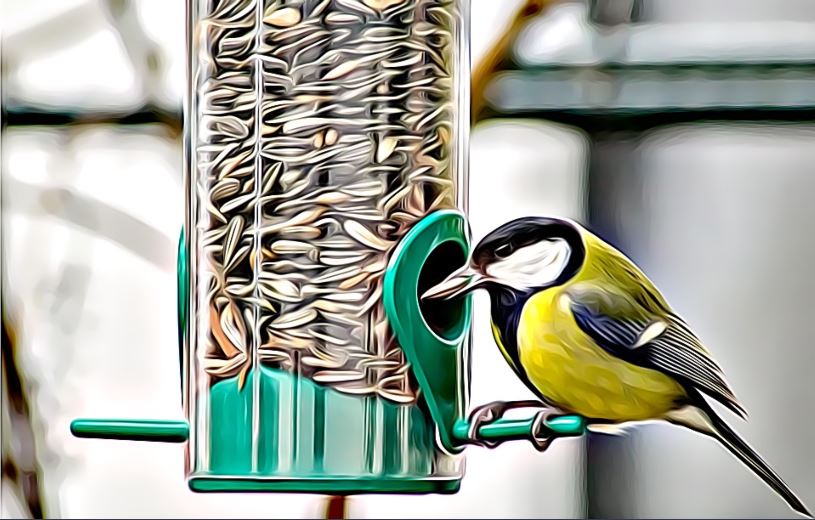
Best Types of Bird feeders
- Ground or window feeder with tray: good for large birds like doves, cardinals, blue jay, and juncos.
- Hanging tube feeders: Good and easy to clean. Suits common backyard bird species, siskins, chickadees, finches, sparrows, and small woodpeckers, and these are squirrel-proof.
- Suet feeder: These are a high-energy healthy fat that is easily digested by birds and good for winter. Also, a suet feeder will attract more variety of birds than a regular seed feeder
- Peanut cage feeder: Peanut is a healthy source of protein which is a favorite for a lot of backyard birds. Peanut feeders can attract wrens, chickadees, nuthatches, brown creepers, woodpeckers, blue jay, and similar birds.
- Fruit feeder: Just like peanuts, fruits are nutritious and a favorite for our little feathered friends. Birds like mockingbirds, orioles, robins, thrashers, sparrows, jays, tanagers, and more songbirds like fruits. Place some a piece of oranges, apples,s or raisins, and berries will the do trick to attract the singers to your garden.
- Sugar water feeder: Good for small birds like hummingbirds and orioles. But there are a few more birds that are attracted to nectar and sugar water like mockingbirds, grosbeaks, tanagers, and especially warblers. To make a sugar-water feeder use a 1:8 ratio in a feeder, like one part white sugar with 8 parts clean water.
Related: How to attract butterflies to your garden
Choose more than one feeder to attract more birds and it also helps to prevent congestion. Avoid honey and other sweeteners which can harm the little ones.
Types of Seeds to Choose for Your Bird Feeder
- Black oil and striped sunflower seeds
- Broken corn
- Sunflower hearts
- Fruits
- Peanuts
- Nyger seeds
- Safflower
- Suet
- Sugar water
- Oats
- Mealworms
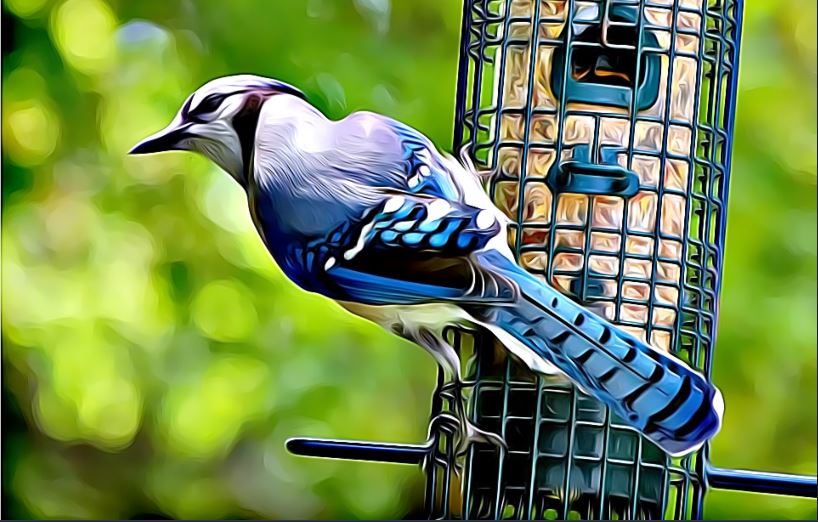
Bird Feeder Attraction Factors and How to Start
- The type of feeder used
- Placement of Feeder (location)
- Noise and surrounding
- Removal of a safe cover
- Type of food in the feeder
- The abundance of natural food sources (will return once the season changes or shortage in the supply of food)
Placement of your feeders like height and safety matters to attract the birds. Hang your feeders above ground at your eye level without any nearby cover that can help their predators.
Avoid noisy and wet areas also, places where the squirrels or cats can’t access.
Spread some new seeds around your feeder, the scattered seeds will be easily visible to the birds passing by. This will slowly make little guests often visit your garden and get attracted to your feeder.
Also, don’t lose hope if birds are not attracted to your feeder. If you are not a regular backyard feeder, it may take anywhere between a few days to a month for the birds to notice.
Avoid filling your feeder up to the neck, wait until the birds have spotted your feeder and started using it. As seeds or food materials may rot and ferment in the case of a hummingbird feeder.
Initially start less and gradually increase the feed in your feeder with everyday flock size.
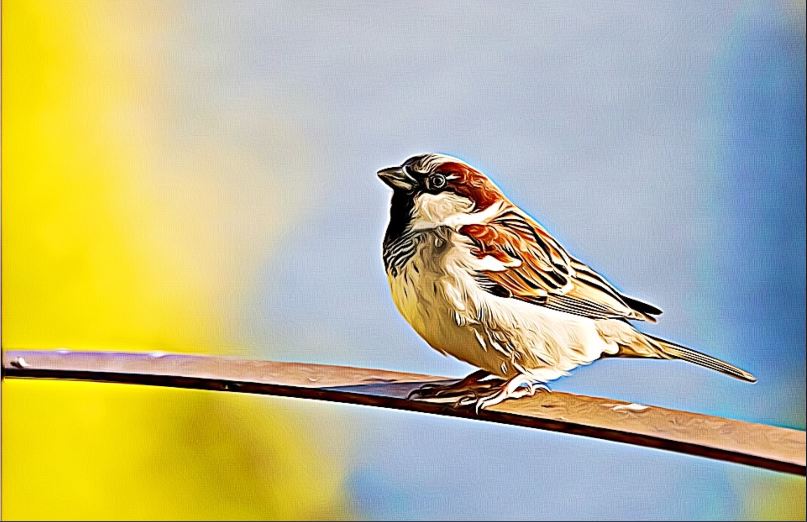
Install a Water Feeder/ Birdbath
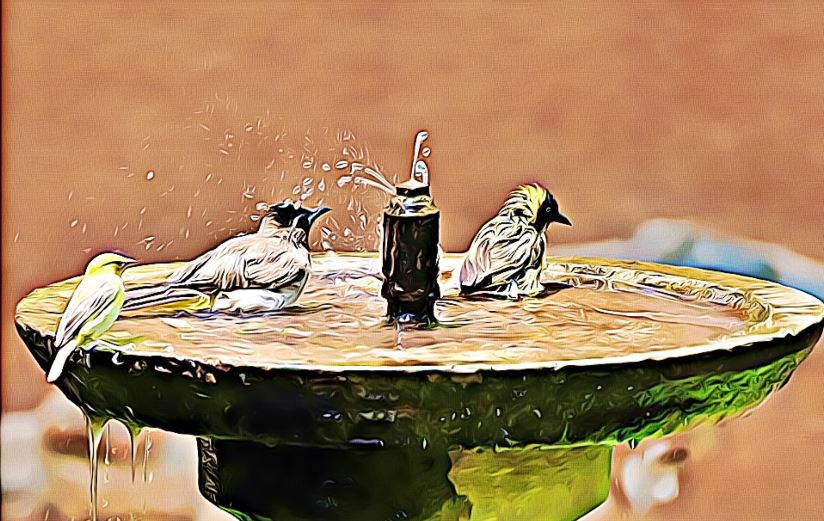
The next need is water, just like we birds need water around the year. Especially for the birds which depend on dry foods like nuts, and seeds.
1. Select a dish or terracotta bowl which is just 2-3 inches deep and shallow enough for the birds to drink and bathe. If the birdbath is deep you can add washed pea gravel/pebbles to adjust the depth and grip.
2. Install or place the birdbath in half shady place, where the water won’t be under direct sunlight for the whole day. So, a shady spot by mid-day keeps the water cool to prevent algae formation and evaporation. Similarly, you can choose to install the hanging water feeders in a shady spot.
Related: How to attract ladybugs to your garden
3. Make sure it is also an eye-catching spot where you will regularly spend time. So that you can enjoy the cute and funny moments of your feathered friends.
4. Add perches nearby the birdbath As birds can take a rest and preen themself and also keep an eye on predators. Having trees or shrubs at a nearby distance is an added advantage, but not too near which would cover a predator.
5. Also adding a dripper or fountain will keep the water in movement which attracts most of the birds passing by. Birds feel the moving water as a reliable source and will surely schedule to visit your garden. This also prevents mosquitoes and algae in your birdbath.
6. You can also go for bigger and wider shallow dishes or multiple birdbaths to attract and entertain more birds.
7. Often clean the dish and refill them with clean water, as everyday usage by a variety of birds could contaminate and spread disease. Once in a while also do scrubbing for deep cleaning to keep the birdbath appealing for birds and your family.
8. On winter days if you have regular visitors, change the water every day or add a mini heater to prevent freezing. Providing warm water during freezing days is surely going to attract new visitors to your garden.
9. Don’t use antifreeze in your birdbath, which is fatal for birds, and avoid using chemicals or salts to clean too.
Provide Shelter and Encourage Nesting
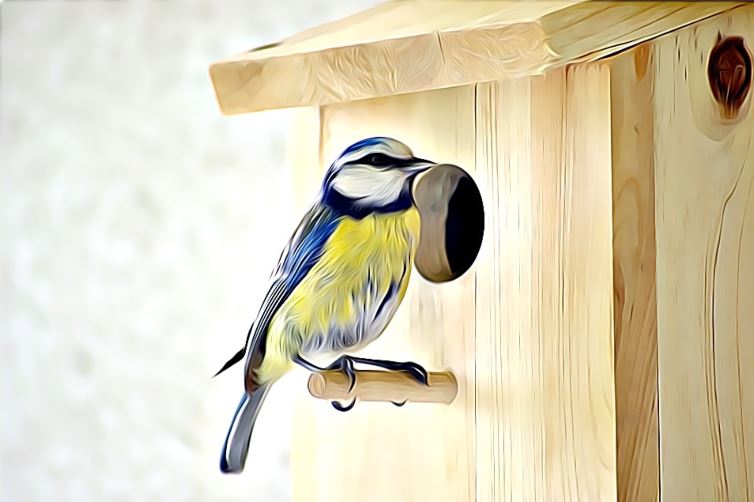
Birds need shelter to protect themself from weather, predators, and breeding. Providing their 3rd basic need will complete all under one roof concept.
You can buy or make a nestbox by yourself for small birds, while some birds opt to build their own nest. If you are about to install multiple nest boxes make sure it’s fixed well and good. As you don’t want it to fall after the birds have occupied it, it’s like a disaster for birds!
Related: How to attract earthworms to your garden
If your garden is safe from predators and rich with the basic building materials for a nest, like coarse for the outer part while fine and soft materials for the inner side, birds will love to hang out.
Leaves or twigs and similar scattered dry materials are good for nesting and good for ecosystem-sheltering insects. Later these insects turn out to be an important food source for birds and their young ones.
Also planting/having densely growing plants, shrubs, trees, and evergreen conifers are added advantages to lure birds for nesting. Few birds even build their nest on your nesting box.
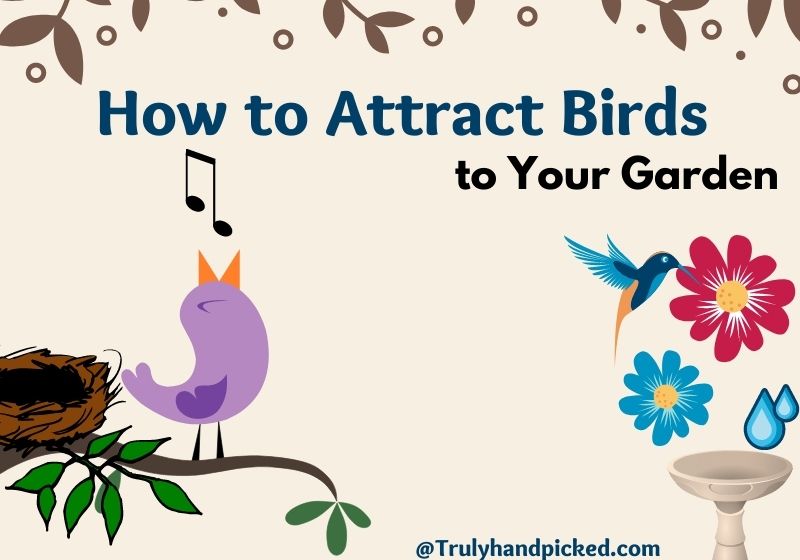
Favorite trees, shrubs, and plants to bring birds to your garden: Maples, oaks, willows, American beech, cedars, dogwood, sweet birch, crabapple, and spruce. Sunflower, honeysuckle, holly, ivy, teasel, hawthorn, black-eyed-susan, daisy, and berries.
You can place the following building materials in tree cavities, wire mesh, or suet cages to grab the attention of birds. With these materials, some birds would make a cup-shaped nest or some would use mud. While some birds good in tailoring would make a pouch few carve trees and get refuge.
Building materials birds would look for their nest:
- Dry dead leaves, twigs, barks, grass stems, reeds, and pine needles.
- Feathers, moss, string, hair, pet fur, and sheep wool
Frequently Asked by Gardeners and Birdwatchers
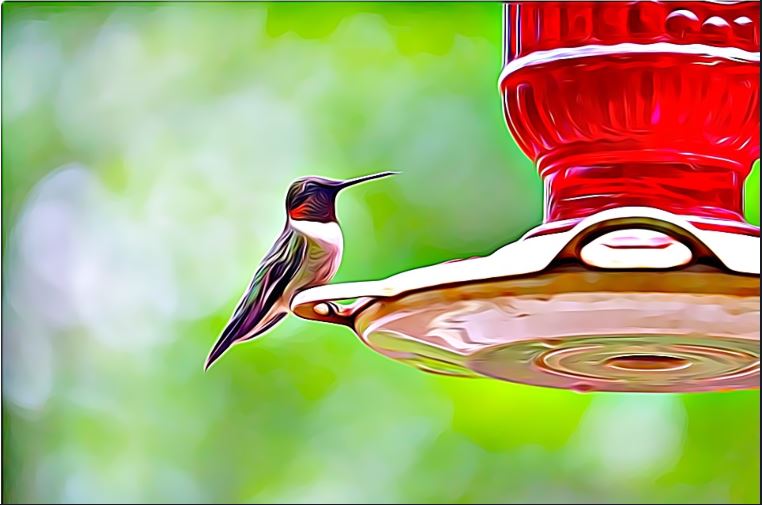
Do feeders attract rodents and snakes? In short yes, as you know birds don’t use forks or napkins to eat neatly, they mess the place around.
Which in turn attracts insects also, rats are attracted to feeders even if your keep your feeders high. When a favorite food is served and incase if snakes are nearby sure they will pay a visit to your garden.
Birds reuse nest: No! birds don’t use the nest again, be it totally clean and there is no wear and tear. Nest in the new site is less likely to be known by their predators and newly build tends to be stronger.
Can you get sick from a bird feeder? Avoid hand-feeding wild birds also wash your hands thoroughly after accessing or cleaning a bird feeder or birdbath. As the chance of salmonella spreading is possible from birds to pets and humans.
Do birds sleep in their nests: After laying eggs, birds sleep in the nest to keep the nestlings warm and safe. Once they are grown and ready to fledge, birds don’t return to the nest to sleep. Later birds sleep on high branches or deep dense bushes to avoid cats and owls.
When should I take down my feeder? When there is a spread of disease, take down your bird feeder to prevent the spread. Since you can’t advise the birds for social distancing, it turns out to be fatal for the little birds.
Favorite flowering plants for nectar lovers like hummingbirds
Red flowering plants, tubular flowers, bee balms, columbines, daylilies, lupines, foxgloves, hollyhocks, impatiens, and petunias
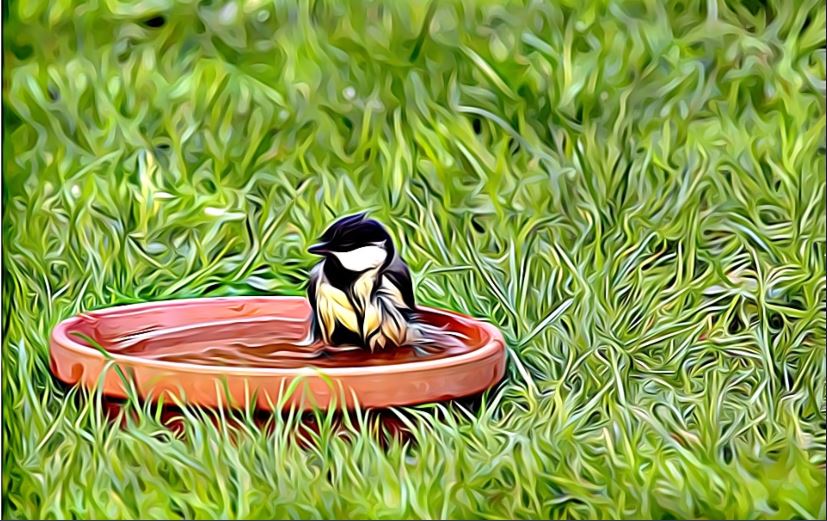
How to Maintain Birdbath Q&A
Tap water for birdbath: Yes! using your tap water is fine until is good to consume for humans. Also, movement in the water and the sound of running water will attract birds to your birdbath
Where to place a birdbath in my garden? A shady spot with less sunlight during the day and trees or shrubs nearby to provide cover or flee immediately after a threat.
Place your birdbath which gives clear visibility for the birds to get alarmed as they are vulnerable while enjoying themself. Also, trees nearby act as perching sites to preen themself after a bath.
Birdbath in winter: Move your birdbath to a warm and sunny place. Making the surface of the birdbath dark will absorb more heat and prevent freezing.
Instead of investing in heaters you can clean, refill and keep them full every day to help the little ones. Don’t use antifreeze solutions in your birdbath as that can be fatal for birds.
Also, instead of hardly melted cold water from a natural source birds would prefer drinking fresh water from your garden. Providing water every day is like a party in your garden, inviting a variety of birds to your birdbath.